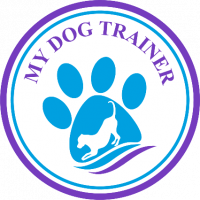Most people think that a dog obeys commands because “he wants to please me” or “because we are the pack leader”. This may be so, but he is really an “opportunistic predator” and either takes advantage of, or manipulates, his environment. Yes, he is a pack animal within a highly developed social structure, but each dog is an individual. A dog is willing to obey if he gets something in return, whether it is escape from negative reinforcement or to get positive rewards.
In our training program we use the new humane, motivational methods. Traditional methods, which are still being taught here in the island, base their training on the use of compulsion or force. The dog obeys commands in order to escape the force – he gets relief from the pain caused by the trainer. For example, in order to teach a dog to sit, he was first choked, then pushed into a sit. When he sat, the choking stopped, and then he was praised. This method caused discomfort and confusion in a dog, especially if he didn’t know what you wanted him to do. Think about it from a human’s point of view – imagine you are in a strange country and can’t speak the language, and someone keeps slapping you and pushing you. You would be confused, resentful and frustrated – what does the person want of you??
In motivational training, a dog is lured into position by using what he is driven by – food or toys. When he obeys a command, he gets his reward – positive reinforcement. If he doesn’t obey, he doesn’t get his reward and the process is calmly started again. The dog is not in any pain; he is neither confused nor stressed out.
I believe that whenever we teach a dog any new skill, we should motivate him to learn it. When he understand the commands but doesn’t obey, only then may we use corrections and/or verbal reprimands – negative reinforcement, but only enough to suit each dog’s temperament, in order not to interfere with the learning process.
It has been proved that dogs learn more quickly using these techniques than by compulsion. The dog is happier and more confident – learning is fun and stress-free. For you, it is easier and you don’t have to physically struggle with your dog which then leads to frustration.
Other factors to consider when training is the age and temperament of your dog. Dogs are not mentally mature until about 18 months old; some breeds and types take even longer. They are still puppies and have short attention spans. Have lots of patience and train in short sessions. The type of praise and corrections given depends on the temperament of the dog. Be calm and quiet with the hyperactive ones, more vigorous and enthusiastic with the lazy dog.
However puppies can be trained from as young as eight weeks – housetraining and some obedience training. Also that old saying “you can’t teach an old dog new tricks” is rubbish. I’ve trained many dogs successfully when they are eight and nine years of age. It is never too early or too late to train your dog, it’s just a lot easier to do so when they are younger and don’t have many bad habits to break.
The dog is a pack animal and you must assume leadership of his pack – if you don’t, he will. When giving commands, do not beg. Give commands in a firm, clear tone of voice. Don’t give a command if you don’t intend to or can’t enforce it. Give a command only once, then act. Praise or correct immediately. Dogs need structure in their lives. Be consistent. Make rules and stick to them, e.g. do not allow your dog on the furniture one day, and scold him the next.
Most dogs obey because there is something in it for them – praise, treats, a toy, or escape from pain. The dog learns to distinguish between command, disapproval and praise. Always praise your dog when he correctly responds to a command. In the learning stage, praise every attempt. When he is fluent in the commands, but responds slowly or poorly, give little or no praise.
We all want our dogs to come when we call them. For his own safety and your convenience, the command “COME” is probably the most important one your dog should learn. Always use an enthusiastic tone of voice for this command. Never punish your dog after calling him; he may stop coming to you. No matter how badly he has misbehaved, you praise him when he comes to you – this must always be a pleasurable experience for him. If you must correct him, you go to him and get him!
Remember that both of you must enjoy training. Keep it short and sweet and always end on a good note by doing something the dog knows how to do.

